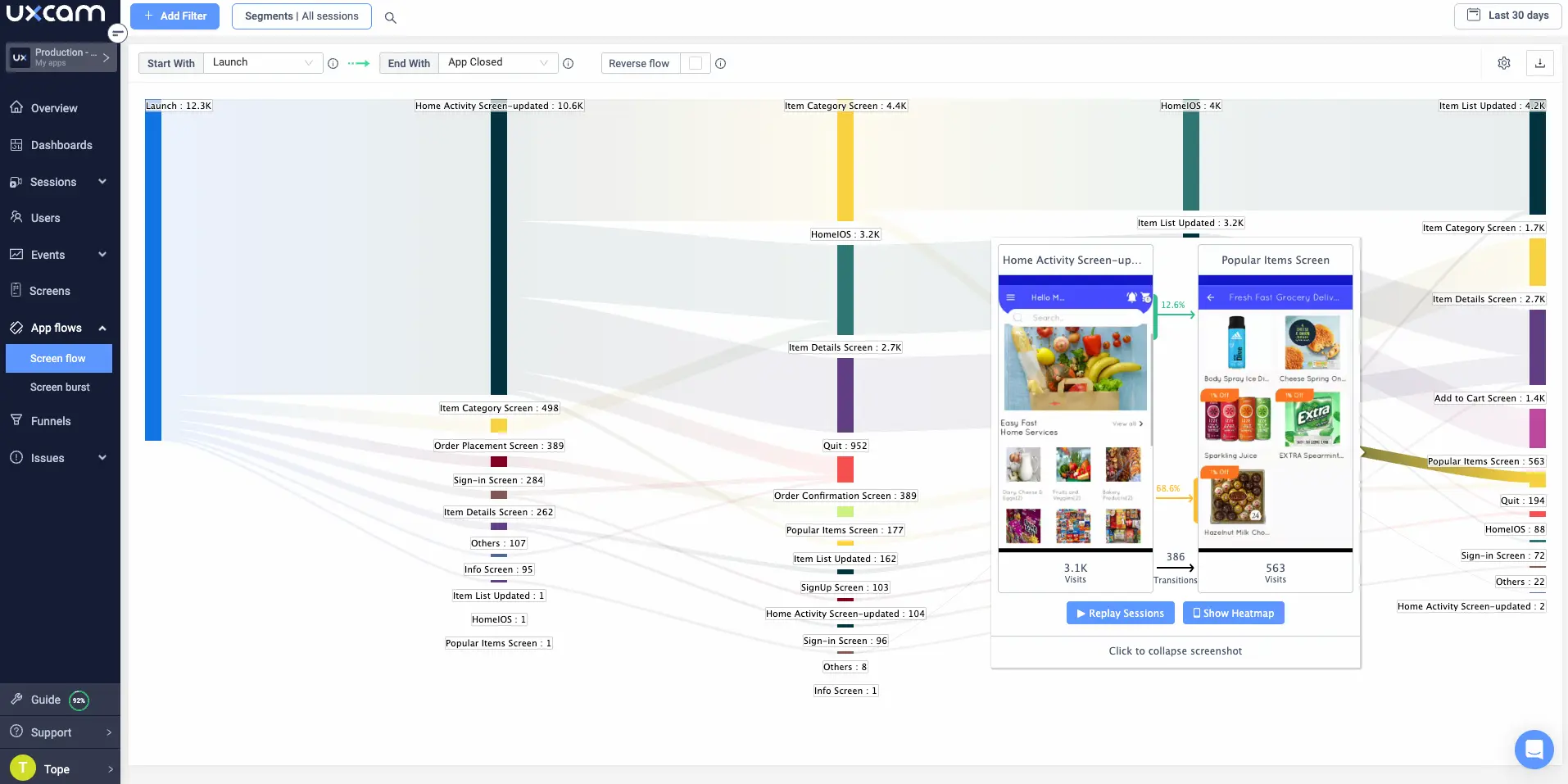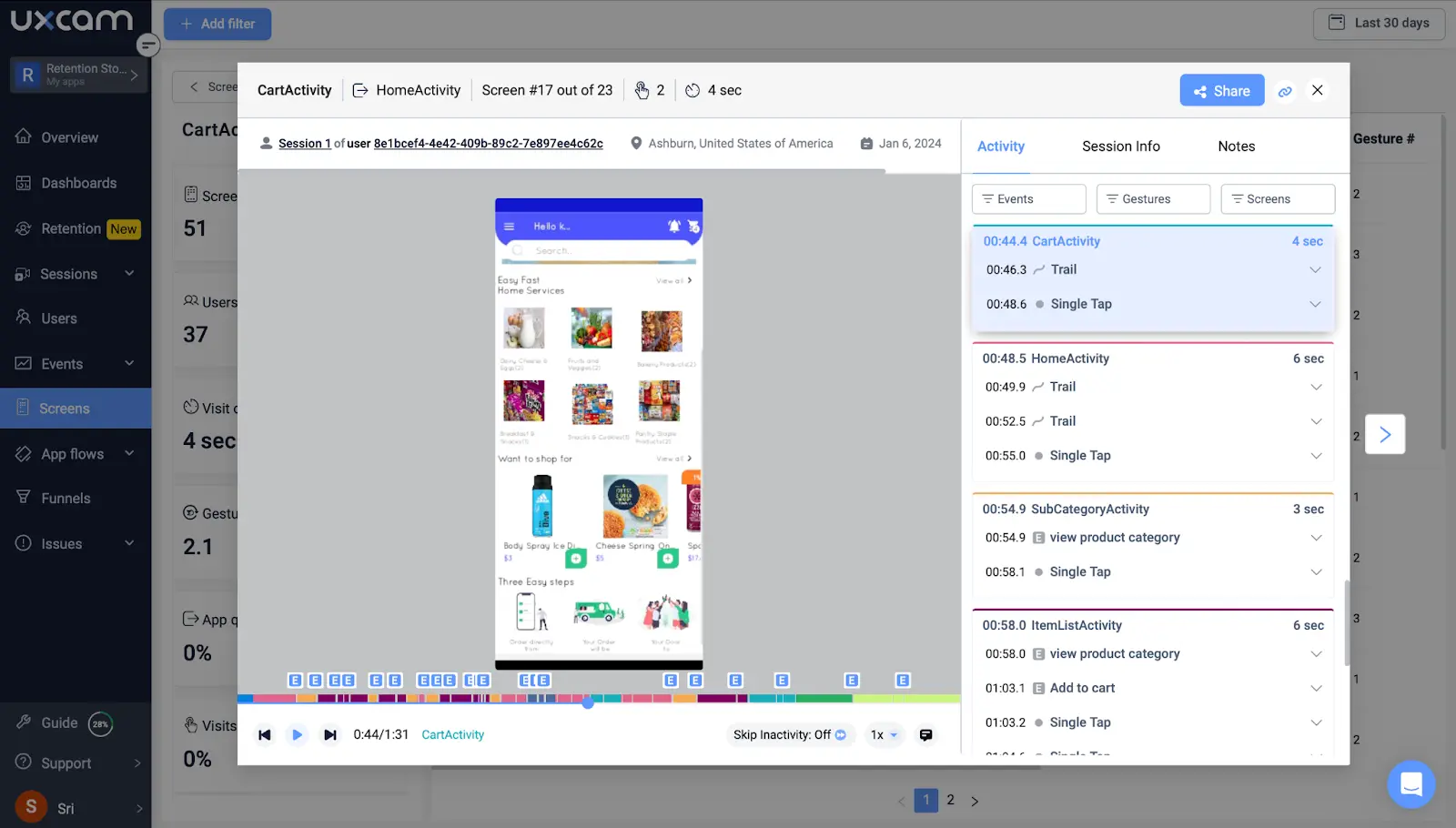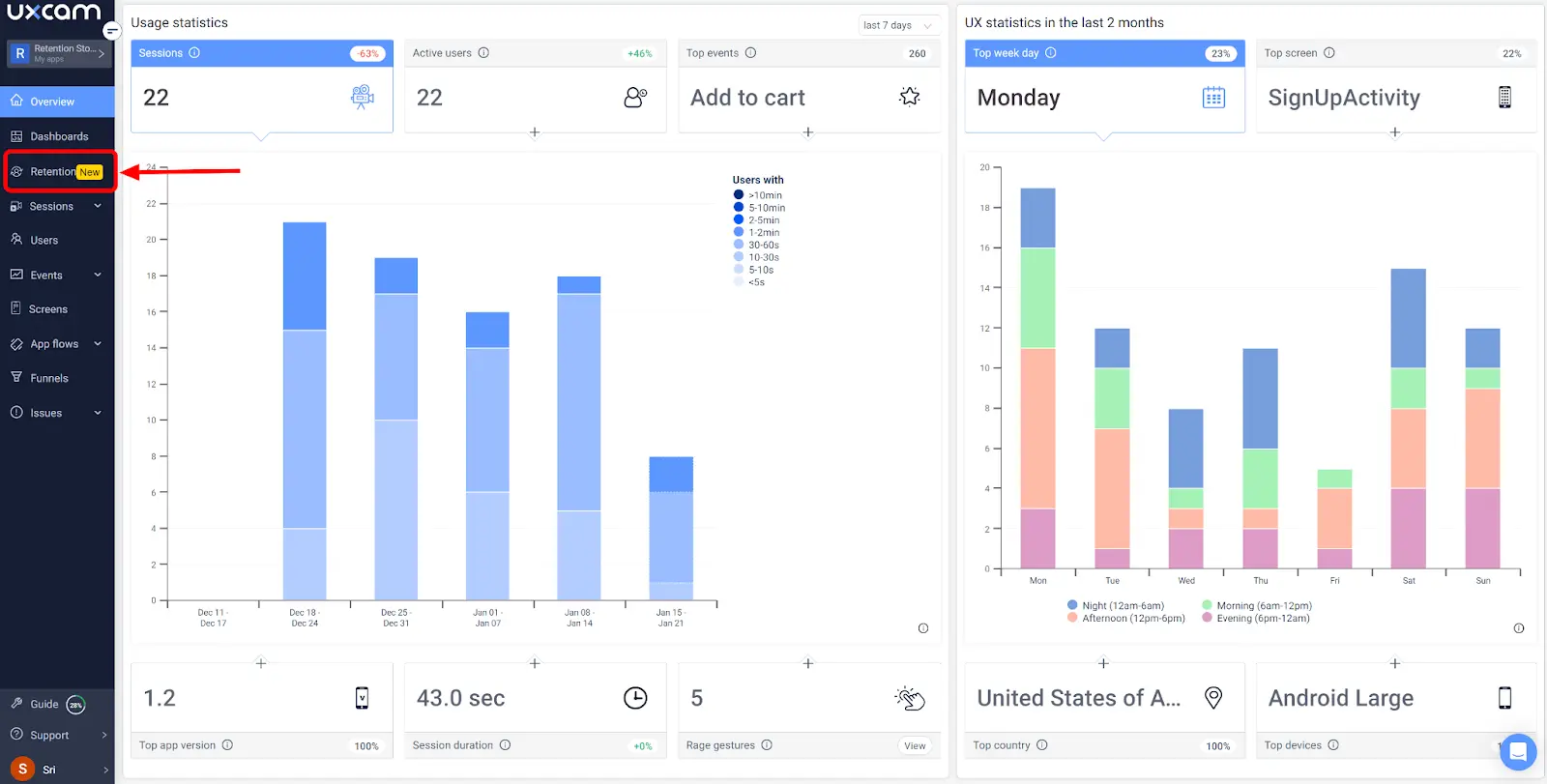Back to blog
6 MIN READ
What is Product Engagement? (and How to Improve it)
PUBLISHED
12 February, 2024

Product Analytics Expert
In a fiercely competitive mobile app landscape, the success of your app hinges not only on functionality and design, but also on how well it engages users. Product engagement captivates users, drives retention, and, ultimately, fosters loyalty.
In this article, we’ll dive into the topic of product engagement—what it is, why it’s important, and how mobile product teams use UXCam to increase engagement.
Let’s dive in.
Helpful summary
Overview: This article offers actionable tips on increasing product engagement for mobile apps. We discuss how product teams use UXCam data to make confident design decisions to boost product engagement.
Why this is important: Mastering techniques to boost product engagement is essential for mobile apps, as it maximizes revenue opportunities and gives you an edge over competitors.
Action points: Streamline your onboarding process and inject some gamification elements for the best chances of product engagement from the start.
Further research: Read our guides on mobile app engagement benchmarking and how to increase mobile app engagement for more info.
Why listen to us?
UXCam is a leader in product and experience analytics for mobile apps. Our data has helped several leading brands boost product engagement.
Costa Coffee is a great example. The product team was losing potential customers due to a high drop-off rate during the app registration process. With an understanding of the behavior surrounding drop-offs, they were able to address customer pain points, resulting in a 15% increase in app registrations.
What is product engagement?
Product engagement refers to the level and quality of interaction that users have with a product. It's essentially a measure of how invested and active they are within the product.
To put it simply, it’s about how much value a user gets out of your product, and how often they come back for more.
A basic example? Daily active users (DAU).
A higher DAU usually means a more engaged user base, but this metric alone isn’t even close to capturing the full picture. Product engagement is a multifaceted concept that considers various metrics and factors, like:
Time spent on the product
Frequency of use
User satisfaction
…and more.
Why is product engagement important?
Product engagement is vital in business for several reasons. It directly impacts customer retention, as highly engaged customers are more likely to stay loyal and continue using your product.
Engaged customers are more likely to tell others about your product, contributing to word-of-mouth marketing and organic growth. Plus, analyzing product engagement provides valuable insights into customer’s preferences, behaviors, and expectations—valuable in guiding improvements and new ideas for product design and marketing strategies.
So let’s see how it’s done!
How to increase product engagement for mobile apps
Below, we will walk you through some practical strategies to increase product engagement in mobile apps;
1. Enhance your onboarding experience
When users find the initial setup process of an app too complex, time-consuming, or confusing, they're more likely to jump ship without fully engaging with its features. The most significant drop-off in user engagement often occurs during the onboarding phase, so nip early drop-off and churn in the bud with a simplified onboarding process.
Here are some ideas:
Streamline it: Minimize the number of steps needed to get started. This can include reducing the amount of information requested from the user or letting users explore the app without a mandatory sign-up.
Include gamification: Consider gamification elements to make onboarding more engaging and interactive. Make a potentially tedious process more fun and memorable with interactive tutorials, virtual rewards, or badges for completing steps. Consider implementing gamification elements, for example, daily or weekly challenges to complete. These can be related to different features or achieving specific goals.
Personalize it: Personalize the process based on the preferences they’ve provided. For example, ask about their interests and tailor the introductory content they receive accordingly.
2. Analyze user behavior and iterate
Analyzing your user’s behavior is key to understanding how they engage with your product and identifying areas for improvement. Here are some UXCam features that care used by product teams to help analyze in-app behavior and product engagement:
Journey analysis
Our journey analysis and funnel analytics features highlight how your users interact with your product through the paths they take. This helps identify popular features, areas where users may struggle, and key points where high engagement or drop-offs occur. Drop-offs can indicate engagement issues or areas for improvement.

By understanding these user patterns, you can optimize the experience to enhance engagement and address friction points. One cool thing about our screen flows is that you can gain more insight into a particular user activity with the option to see a replay of their session or heatmap information.
Speaking of…
Session replays
Our session replays allow you to observe the user’s natural interaction during sessions from start to finish. Our data provides insights into behavior, preferences, and pain points. Observing how they use the app in their environment will tell you the truth about their engagement levels.

For example, UXCam makes it easy to identify behavior patterns to help you identify patterns indicating engagement or disinterest. Learning design struggle and frustration elements is a must, as it negatively impacts engagement levels. UXCam highlights the areas that need to be addressed.
Heatmaps
Our heatmaps show you the elements where users interact most frequently, thus highlighting popular features or areas of high engagement. You’ll learn navigation patterns like where users tap, swipe, or scroll. UXCam offers a deeper understanding of emotion through details like rage taps and gestures.

3. Get customer feedback
Find out what your customers think about your product for more insights into engagement. Here are some ways you can collect opinions:
User interviews: Conduct one-on-one interviews with users to gain deep insights into their experiences and opinions.
Feedback widgets: Implement feedback widgets in your app, so users can easily provide suggestions or report issues.
In-app surveys: Embed short surveys within the app to get quick feedback from users during or after specific interactions.
4. Leverage analytics, feedback, and iterate
Use your collected data to make data-driven design decisions for product engagement improvements.
For example:
Analyze user paths to streamline navigation and enhance UX.
Identify popular features through user interaction data and focus on their improvement.
Use segmentation data to tailor the experience to make it more relevant and engaging. For example, UXCam groups users into new, returning or, loyal, and slipping away users. This makes it easy to guide feature design and content tailored to address common behaviors that result in low engagement.
Use your user feedback data to find out more about common pain points, gauge the popularity of features, and learn user expectations. Tailoring your product based on feedback and behavior leads to a more satisfying user experience and loyal customers.
Analysis should be carried out iteratively to maintain product engagement by keeping up with changing user requirements.
5. Continuously monitor product engagement
Continuously monitoring your product engagement helps you to identify trends and patterns, address issues quicker, and increase retention and monetization.
How to measure product engagement
Here are some key metrics to track.
DAU and MAU: Daily and monthly active users give you a snapshot of your app’s popularity daily and over a longer period.
User stickiness: The ratio of DAU to MAU indicates how often users return within a given time frame. Higher stickiness indicates more engaged users.
Session length: The average time a user spends in a single session within your app. Longer session lengths generally indicate higher engagement.
Session interval: The time gap between consecutive user sessions. Shorter intervals suggest higher engagement due to users returning more frequently.
Conversion rate: Measure the percentage of users who complete a desired action, like purchasing or signing up. A higher conversion rate indicates effective engagement.
Churn rate: The rate at which users stop using your app over time. Lower churn rates indicate better user retention and engagement.
Retention rate: The percentage of users who return to your app after their initial use. This can be measured over different periods (e.g., 1, 7, or 30 days) to understand long-term engagement.
Tracking all these metrics (and more) is easy with UXCam.

Our flexible, modular dashboards and library of pre-built reports make it simple to track key metrics and analyze user behavior. Just create a dashboard, drag reports onto it, and start tracking. You can even invite team members to collaborate and share insights.
Use UXCam to enhance product engagement
Product teams need to prioritize user engagement to stay relevant and successful.
Incorporate these steps into your mobile app development to significantly enhance product engagement. Continuously analyze in-app behavior, listen to your users, and iterate designs based on their data and their feedback to create an app that attracts and keeps users engaged over time.
UXCam is the mobile analytics platform of choice for product teams working on enhancing product engagement. Sign up for a free trial or request a demo to learn why.
You might also be interested in these;
How to calculate churn rate for mobile apps product
How to build an effective product funnel
Product hypothesis - A guide to create meaningful hypotheses
AUTHOR

Tope Longe
Product Analytics Expert
Ardent technophile exploring the world of mobile app product management at UXCam.
What’s UXCam?
Related articles
App Analytics
Mobile App Tracking: Practical Guide & Best Tools [2026]
The best tracking tools for mobile...

Jonas Kurzweg
Product Analytics Expert
App Analytics
Top Analytics SDKs 2026
Pick the right analytics SDKs to improve your app's...

Jonas Kurzweg
Product Analytics Expert
Product best practices
8 Best UX Analytics Tools and Software We’ve Tested 2025
A good UX design is key when it comes to user satisfaction. Learn about five of the best UX analytics tools you can use to get valuable insights about user...

Jonas Kurzweg
Product Analytics Expert


